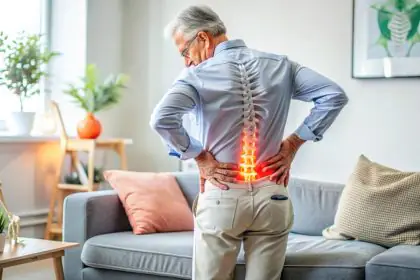Thoracic back pain is a common and often overlooked condition that affects the middle and upper part of the spine, between the neck and the lower back.
The thoracic spine consists of 12 vertebrae, which are connected by joints, discs, ligaments, muscles, and nerves.
The thoracic spine supports the rib cage, protects the vital organs, and allows the movement of the upper body.
Thoracic back pain can range from mild to severe, and can be acute or chronic.
Thoracic back pain can interfere with your daily activities and quality of life, and sometimes lead to complications, such as nerve damage, spinal deformity, or respiratory problems.
If you are suffering from thoracic back pain, you may wonder what are the causes, symptoms, diagnosis, and treatment of this condition.
In this blog post, we will answer these questions and provide you with some tips and advice on how to manage and prevent thoracic back pain.
What Are the Causes of Thoracic (Middle and Upper) Back Pain?
There are many possible causes of thoracic back pain, which can be classified into two categories: mechanical and non-mechanical.
Mechanical causes are related to the structure and function of the spine, such as:
Poor posture
Sitting or standing in a slouched or hunched position for prolonged periods can put stress and strain on the thoracic spine, leading to muscle tension, joint inflammation, and disc degeneration.
Muscle strain
Lifting, twisting, or bending the upper body in an awkward or excessive way can cause injury or overuse of the muscles that support the thoracic spine, resulting in pain, stiffness, and spasms.
Joint dysfunction
The joints that connect the vertebrae and the ribs can become inflamed, irritated, or misaligned due to trauma, arthritis, or wear and tear, causing pain, swelling, and reduced mobility.
Disc herniation
The discs that act as cushions between the vertebrae can bulge or rupture due to aging, injury, or degeneration, causing pain, numbness, and weakness in the affected area or the limbs.
Spinal stenosis
The narrowing of the spinal canal or the openings where the nerves exit the spine can compress the spinal cord or the nerve roots, causing pain, tingling, and loss of sensation or function in the affected area or the limbs.
Scoliosis
The abnormal curvature of the spine to the side can cause pain, stiffness, and deformity of the thoracic spine, as well as affect the breathing and the heart function.
Osteoporosis
The loss of bone density and strength due to aging, hormonal changes, or nutritional deficiencies can cause the vertebrae to become brittle and prone to fractures, causing pain, height loss, and spinal deformity.
Non-mechanical causes are related to other medical conditions or factors that affect the spine, such as:
Infection
The infection of the vertebrae, the discs, or the spinal cord by bacteria, viruses, or fungi can cause pain, fever, and inflammation of the thoracic spine, as well as affect the nervous system and the immune system.
Inflammation
The inflammation of the spine or the surrounding tissues by autoimmune disorders, such as ankylosing spondylitis, rheumatoid arthritis, or psoriatic arthritis, can cause pain, stiffness, and swelling of the thoracic spine, as well as affect the joints, the skin, and the eyes.
Tumor
The growth of abnormal cells in or near the spine, either benign or malignant, can cause pain, pressure, and damage to the thoracic spine, as well as affect the nervous system and the organ function.
Trauma
The injury or damage to the spine or the spinal cord by accidents, falls, or violence can cause pain, bleeding, and fracture of the thoracic spine, as well as affect the nervous system and the organ function.
Referred pain
The pain that originates from other parts of the body, such as the heart, the lungs, the stomach, or the gallbladder, can be felt in the thoracic spine, due to the shared nerve pathways or the proximity of the organs.
Thoracic back pain symptoms
The symptoms of thoracic back pain may vary depending on the cause, severity, and location of the condition.
Some of the common symptoms of thoracic back pain are:
- Pain in the middle or upper back, which may be dull, sharp, burning, or throbbing, and may radiate to the chest, the abdomen, the shoulders, the arms, or the legs.
- Stiffness or reduced mobility of the upper body, which may limit the ability to bend, twist, or turn the head or the torso.
- Muscle spasms or tightness in the back, which may cause involuntary contractions or cramps of the muscles.
- Numbness, tingling, or weakness in the affected area or the limbs, which may indicate nerve compression or damage.
- Difficulty breathing, coughing, or swallowing, which may indicate respiratory problems or esophageal problems.
- Chest pain, palpitations, or sweating, which may indicate cardiac problems or angina.
- Abdominal pain, nausea, or vomiting, which may indicate gastrointestinal problems or gallbladder problems.
Thoracic Back Pain Diagnosis
The diagnosis of thoracic back pain involves a physical examination, a medical history, and some tests, such as:
Physical examination
The doctor will check your posture, your spine alignment, your range of motion, your muscle strength, your reflexes, and your sensation, and look for any signs of inflammation, infection, or deformity.
The doctor will also palpate your spine and your ribs, and ask you to perform some movements or maneuvers, to identify the source and the extent of your pain.
Medical history
The doctor will ask you some questions about your pain, such as when it started, how it feels, where it is located, what makes it better or worse, and how it affects your daily activities.
The doctor will also ask you about your medical history, such as any previous injuries, illnesses, surgeries, or treatments, and your family history, such as any genetic or hereditary conditions.
The doctor will also ask you about your lifestyle, such as your diet, your exercise, your smoking, your alcohol, or your drug use, and your stress level, as they may affect your spine health.
Tests
The doctor may order some tests to confirm the diagnosis and rule out any other conditions, such as:
X-rays
These are images that show the structure and the alignment of the spine and the ribs, and can detect any fractures, dislocations, or deformities.
MRI
This is a scan that uses magnetic fields and radio waves to produce detailed images of the spine and the surrounding tissues, and can detect any disc herniation, spinal stenosis, tumor, infection, or inflammation.
CT scan
This is a scan that uses X-rays and a computer to create cross-sectional images of the spine and the surrounding tissues, and can detect any bone spurs, calcifications, or fractures.
Blood tests
These are tests that measure the levels of certain substances in the blood, such as white blood cells, red blood cells, or inflammatory markers, and can detect any infection, inflammation, or anemia.
Urine tests
These are tests that measure the levels of certain substances in the urine, such as proteins, glucose, or ketones, and can detect any kidney problems, diabetes, or dehydration.
Bone scan
This is a test that uses a radioactive tracer that is injected into the bloodstream and accumulates in the bones, and can detect any bone abnormalities, such as osteoporosis, fracture, or tumor.
EMG
This is a test that measures the electrical activity of the muscles and the nerves, and can detect any nerve damage or dysfunction.
Nerve conduction study
This is a test that measures the speed and the strength of the nerve signals, and can detect any nerve compression or damage.
Thoracic back pain Treatment
The treatment of thoracic back pain depends on the cause, severity, and duration of the condition.
The main goals of the treatment are to relieve the pain, reduce the inflammation, restore the mobility, and prevent the complications.
The treatment of thoracic back pain may include:
Medications
The doctor may prescribe some medications to help with the pain and the inflammation, such as:
Analgesics
These are painkillers that can reduce the pain, such as acetaminophen, ibuprofen, or naproxen.
Anti-inflammatories
These are medications that can reduce the inflammation, such as aspirin, ibuprofen, or naproxen.
Muscle relaxants
These are medications that can relax the muscles and ease the spasms, such as cyclobenzaprine, baclofen, or tizanidine.
Antidepressants
These are medications that can improve the mood and the sleep quality, and also have some analgesic effects, such as amitriptyline, duloxetine, or venlafaxine.
Anticonvulsants
These are medications that can stabilize the nerve activity and reduce the pain, such as gabapentin, pregabalin, or carbamazepine.
Opioids
These are strong painkillers that can reduce the thoracic back pain, such as codeine, morphine, or oxycodone. However, these medications should be used with caution, as they can cause addiction, dependence, or overdose.
Physical therapy
The doctor may refer you to a physical therapist, who can help you with some exercises and techniques to improve your posture, your spine alignment, your muscle strength, your flexibility, and your mobility.
The physical therapist may also use some modalities, such as heat, cold, ultrasound, or electrical stimulation, to reduce the pain and the inflammation.
Physical therapy can help you recover from your injury, prevent further damage, and reduce the recurrence of your pain.
Massage therapy
The doctor may recommend you to see a massage therapist, who can help you with some massage techniques to relax your muscles, improve your blood circulation, and release your endorphins.
Massage therapy can help you reduce the pain, the stiffness, and the spasms, as well as improve your mood and your sleep quality.
Acupuncture
The doctor may suggest you to try acupuncture, which is a traditional Chinese medicine practice that involves inserting thin needles into specific points on your body.
Acupuncture can help you stimulate your nerves, your muscles, and your connective tissues, and balance your energy flow.
Acupuncture can help you reduce the pain, the inflammation, and the nausea, as well as improve your immune system and your well-being.
Chiropractic
The doctor may advise you to visit a chiropractor, who can help you with some spinal manipulations or adjustments to correct the alignment and the function of your spine and your joints.
Chiropractic can help you reduce the pain, the inflammation, and the nerve compression, as well as improve your mobility and your nervous system.
Surgery
The doctor may recommend surgery as a last resort, if your condition is severe, chronic, or unresponsive to other treatments, and if it causes serious complications, such as nerve damage, spinal deformity, or organ dysfunction.
Surgery can help you remove the source of your pain, such as a disc herniation, a spinal stenosis, a tumor, an infection, or a fracture, and stabilize your spine, such as with a fusion, a rod, or a cage.
Surgery can help you relieve the pain, restore the function, and improve the quality of life.
However, surgery also has some risks and complications, such as infection, bleeding, nerve injury, or failure, and requires a long recovery time and rehabilitation.
When to contact a doctor
You should contact your doctor if you have thoracic back pain that:
- Is severe, persistent, or recurrent
- Is accompanied by fever, chills, or night sweats
- Is accompanied by chest pain, shortness of breath, or palpitations
- Is accompanied by abdominal pain, nausea, or vomiting
- Is accompanied by numbness, tingling, or weakness in the affected area or the limbs
- Is accompanied by difficulty breathing, coughing, or swallowing
- Is accompanied by loss of bladder or bowel control
- Is caused by trauma, injury, or violence
- Is not relieved by rest, medication, or home remedies
- Affects your daily activities and quality of life
Can you prevent thoracic back pain?
You can prevent thoracic back pain by following some tips and advice, such as:
Maintain a good posture
Keep your spine straight and aligned, your shoulders back and relaxed, your chest open and lifted, and your head and neck in a neutral position.
Avoid slouching, hunching, or leaning forward, especially when sitting, standing, or working. Use a supportive chair, a cushion, or a lumbar roll to support your back.
Adjust your desk, your computer, your keyboard, and your mouse to a comfortable height and distance. Take frequent breaks and stretch your back, your neck, and your shoulders.
Lift properly
Use your legs and your core muscles to lift, not your back. Keep the object close to your body, and avoid twisting, bending, or reaching. Use a cart, a dolly, or a partner to help you with heavy or awkward objects. Wear a back brace or a belt to support your back.
Exercise regularly
Do some exercises that can strengthen your back, your core, your chest, and your shoulders, such as planks, bridges, push-ups, or rows.
Do some exercises that can stretch your back, your neck, and your shoulders, such as cat-cow, child’s pose, or neck rolls.
Do some exercises that can improve your cardiorespiratory fitness, such as walking, jogging, swimming, or cycling.
Aim for at least 30 minutes of moderate exercise, five times a week.
Consult your doctor or a physical therapist before starting any exercise program, and avoid any exercises that cause or worsen your pain.
Manage your weight
Maintain a healthy weight, as excess weight can put pressure and strain on your spine and your joints.
Eat a balanced diet, rich in fruits, vegetables, whole grains, lean proteins, and healthy fats.
Avoid processed foods, refined sugars, saturated fats, and trans fats.
Drink plenty of water, and limit your intake of alcohol, caffeine, and soda.
Consult your doctor or a nutritionist for guidance on your ideal weight and diet.
Manage your stress
Reduce your stress level, as stress can cause muscle tension, inflammation, and pain.
Practice some relaxation techniques, such as deep breathing, meditation, yoga, or tai chi.
Engage in some hobbies or activities that make you happy, such as reading, listening to music, gardening, or painting.
Seek professional help or counseling if you have any emotional or mental issues, such as anxiety, depression, or trauma.
Quit smoking
Quit smoking, as smoking can impair your blood circulation, reduce your bone density, and increase your inflammation, which can all contribute to back pain.
Seek professional help or use some aids, such as nicotine patches, gums, or lozenges, to help you quit smoking.
Avoid exposure to secondhand smoke, as it can also harm your health and your spine.
Conclusion
Thoracic back pain is a common and often overlooked condition that affects the middle and upper part of the spine, between the neck and the lower back.
Thoracic back pain can be caused by various mechanical or non-mechanical factors, such as poor posture, muscle strain, joint dysfunction, disc herniation, spinal stenosis, scoliosis, osteoporosis, infection, inflammation, tumor, trauma, or referred pain.
Thoracic back pain can cause various symptoms, such as pain, stiffness, spasms, numbness, tingling, weakness, difficulty breathing, chest pain, abdominal pain, or nausea.
Thoracic back pain can be diagnosed by a physical examination, a medical history, and some tests, such as X-rays, MRI, CT scan, blood tests, urine tests, bone scan, EMG, or nerve conduction study.
Thoracic back pain can be treated by various methods, such as medications, physical therapy, massage therapy, acupuncture, chiropractic, or surgery.
Thoracic back pain can be prevented by following some tips and advice, such as maintaining a good posture, lifting properly, exercising regularly, managing your weight, managing your stress, and quitting smoking.
Thoracic back pain is a treatable and preventable condition that can affect your health and well-being.
By following these tips and guidelines, you can find the best treatment and prevention for your thoracic back pain and enjoy the benefits of a healthy and pain-free spine.
FAQs
What are the common causes of thoracic back pain?
Thoracic back pain can be caused by various factors, including muscle strain, poor posture, herniated discs, osteoarthritis, fractures, and conditions like scoliosis or kyphosis.
When should I seek medical attention for thoracic back pain?
If your thoracic back pain is severe, persistent, or accompanied by other symptoms like numbness, tingling, or weakness, it’s advisable to seek medical attention promptly.
Additionally, if the pain follows an injury or trauma, medical evaluation is recommended.
How is thoracic back pain diagnosed by healthcare professionals?
Diagnosis typically involves a thorough medical history, physical examination, and may include imaging studies such as X-rays, MRI, or CT scans.
Sometimes, blood tests or other diagnostic procedures may be necessary to identify the underlying cause.
What are conservative treatments for thoracic back pain?
Conservative treatments may include rest, physical therapy, exercises to improve posture and strength, pain medications, and the application of heat or ice.
Lifestyle modifications, ergonomic changes, and avoiding activities that worsen the pain can also be part of the treatment plan.
Are there surgical options for thoracic back pain?
In some cases, surgery may be considered if conservative treatments are ineffective or if there’s an underlying structural issue that requires intervention.
Surgical options may include procedures to address herniated discs, spinal fusion, or other corrective measures depending on the specific diagnosis.
Can thoracic back pain be prevented?
While not all cases of thoracic back pain can be prevented, maintaining good posture, engaging in regular exercise to strengthen the back muscles, and avoiding prolonged periods of sitting or standing can contribute to overall spinal health.
Regular stretching and ergonomic adjustments in work or daily activities can also help prevent thoracic back pain.





